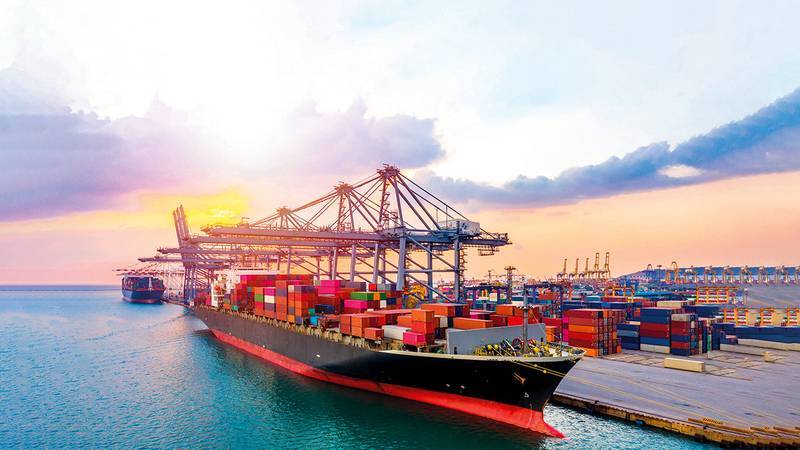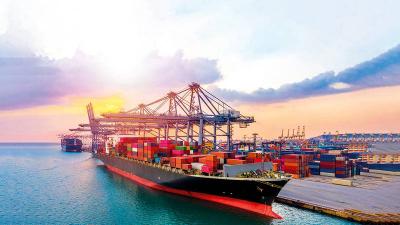The non-oil foreign trade of the United Arab Emirates experienced a growth of 36.5% during the third quarter of last year compared to the second quarter of the same year, despite the repercussions of the COVID-19 pandemic that impacted international trade and global economies. This percentage reflects a significant increase compared to the same period in 2019, which recorded a growth of 2.3%.
**Exports and Imports**
An analytical study by the Ministry of Economy on non-oil foreign trade rates on a quarterly basis showed that the contribution of exports rose by 40.8% in the third quarter compared to the second quarter of 2020, accounting for 19.9% of the total non-oil foreign trade of the state. During the same comparison period, imports grew by 23.5%, making up 51.7% of total non-oil foreign trade, while re-exports surged by 64%, representing 28.4%.
**Rapid Recovery**
Dr. Thani bin Ahmed Al Zeyoudi, Minister of State for Foreign Trade, confirmed that these figures are a clear indicator of the rapid recovery of the UAE's foreign trade, demonstrating its ability to swiftly return to pre-pandemic levels and achieve robust growth rates despite restrictions imposed on trade, transportation, shipping, and business activities globally. This underscores the country’s prominent position as a vital trade gateway between the East and West.
He explained that this growth is attributed to the proactive approach adopted by the UAE, guided by its wise leadership in managing the pandemic and mitigating its impacts, as well as the effectiveness of national strategies aimed at enhancing the resilience and diversification of the national economy, alongside a wide range of qualitative initiatives and incentives launched by the government to boost trade movement and investment flows with global partners.
**Key Trade Routes**
Al Zeyoudi added that the UAE has succeeded in enhancing its position as one of the most important trade corridors for the movement of goods on the global trade map, ranking third worldwide in re-exports and being among the top twenty in goods exports and imports.
**Global Competitiveness**
According to a recent report by the Federal Competitiveness and Statistics Authority, the UAE ranked among the top twenty countries in 16 competitiveness indicators globally in the foreign trade sector during 2020. These include the Global Competitiveness Yearbook published by the International Institute for Management Development, the Global Competitiveness Report 4.0 from the World Economic Forum, the Logistics Performance Index from the World Bank, and the Global Innovation Index by INSEAD and the World Intellectual Property Organization.
The report highlighted the leading role of the foreign trade system across various axes, notably in efficiency indicators for border clearance, customs, creative goods exports, and trade protection policy.
**National Agenda**
Six indicators out of the total 16 mentioned in the report fall under the National Agenda for UAE Vision 2021, categorized into three main indicators: the Global Competitiveness Report 4.0, which includes sub-indicators such as “Efficiency of border clearance” where the UAE ranked 15th globally, “Imports of goods and services” where it ranked 19th globally, and “Low prevalence of non-tariff barriers” where it ranked 9th globally.
The second indicator is the Global Innovation Index, which includes sub-indicators like “Exports of creative goods” where the country ranked 8th globally, and “National feature films” where it ranked 18th globally. The third indicator is the Logistics Performance Index including the “Customs” sub-indicator where the UAE ranked 15th globally.
**Contributions of Product Groups**
The analytical study from the Ministry of Economy revealed that the contributions of product groups to the UAE's non-oil foreign trade during the first nine months of last year were as follows: machinery, electrical devices and equipment contributed 26.8% with a value of approximately 277 billion dirhams, followed by gold, diamonds, jewelry, and ornaments accounting for 24.5% with a value of around 255 billion dirhams, and transport equipment valued at 103 billion dirhams, with a contribution percentage of 10%, up from 8.9% during the same period in 2019.
Following these were metals and their products valued at 71.4 billion dirhams, and chemical products or related industries valued at 59 billion dirhams. The total contribution of these groups was 74%, compared to 26% for all other groups, noting that the total volume of non-oil foreign trade for the state during the first nine months of 2020 reached 1.033 trillion dirhams.
**Three Main Focuses**
Dr. Thani bin Ahmed Al Zeyoudi mentioned that the Ministry of Economy is focusing on three main axes to support national exports at the current stage: first, implementing and developing plans and initiatives for trade recovery from the effects of COVID-19, and developing a sustainable developmental path for the trade sector in the country. The second focus is promoting Emirati products and developing programs to enhance the efficiency of UAE products and increase export capacity, alongside providing protection and credit tools for transactions carried out by national producing companies, while identifying key markets suitable for Emirati products and diversifying export destinations. The third focus is the continuous development of the country’s trade policies and establishing effective methodologies to address the protectionist policies of external countries and defend national exports in various international markets, aligning with World Trade Organization agreements.




